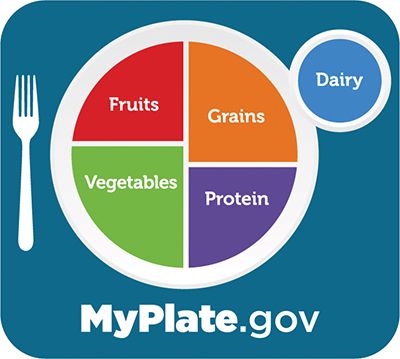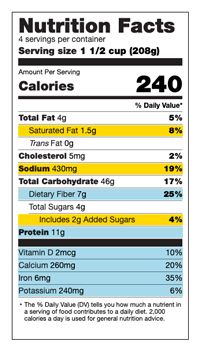What should I eat to lower my blood pressure?
The short answer: eat more whole foods and less processed food. (A good rule of thumb: if the food doesn’t rot, it’s probably processed.)
Less than 2,300mg of sodium (about 1 teaspoon of salt) a day
- Sodium, the main ingredient in salt, has a huge effect on blood pressure.
- Research shows that a low-salt diet can lower blood pressure in as little as one week. (See below for tips on avoiding salt.)
5 servings of fruits and vegetables a day
- For variety all year long, choose produce that’s in season (frozen is a great, budget-friendly option).
- At mealtime, try to fill half your plate with vegetables and fruit, a quarter with lean protein, and a quarter with whole grains.
Potassium-rich foods
- Potassium loosens your blood vessels and gets rid of sodium.
- It’s in many fruits (like apricots, bananas, cantaloupe, kiwi), veggies (like tomatoes, spinach, and potatoes), dairy and plant-based milks and yogurts, beans, salmon and halibut, and nuts.
25-35g of fiber a day
- Fiber is linked with lower blood pressure.
- Fiber-rich foods include fruits, veggies, whole grains, nuts, and seeds. (See how much fiber is in each.)
Zero-calorie drinks
- Dehydration can cause big swings in blood pressure.
- Water, seltzer, and tea without sugar are all good ways to stay hydrated (and help balance out the fiber in your diet).

How do I eat less salt?
Cook more, eat out less
- Most restaurant food has lots of sodium. When you cook at home, you’re in control.
- Aim for using little to no salt in home-cooked food. Instead, add flavor with extra herbs, spices, vinegar, and citrus.
Cut down on processed foods
- Processed foods are any foods that have been changed in some way — everything from potato chips to bologna to canned corn.
- If you buy them, choose ones labeled low-sodium or no-sodium. (And make sure to rinse canned veggies and beans.)
Focus on the outer aisles of the grocery store
- These aisles tend to have healthy foods, like produce, fish, eggs, and dairy.
- Processed and high-sodium stuff — like snacks, soups, sauces, packaged mixes, and frozen prepared foods — usually live in the center aisles.
- Keep in mind: some healthy foods, like whole grains, live in the center aisles too.
Use less condiments
- Soy sauce and other sauces, dips, dressings, ketchup, mustard, and relish all contain sodium.
- Try making your own versions (even a simple combo of olive oil and vinegar can brighten up your salad).
Read nutrition labels on packaged foods. More on that below.
How do I read nutrition labels on packaged foods?
Nutrition labels can help you understand which foods are more or less nutritious before you buy them.
1. Look at the percent daily values (% DV)
This is the percentage next to each nutrient on the label. It tells you how much a nutrient in one serving of that food contributes to the average person’s total daily diet.
- Example:
If the label lists the % DV of fiber as 25%, that means one serving of that food would give 25% of the fiber you need for the day. If the % DV of total fat is 5%, one serving would give you 5% of the total fat you should have for the day.
2. Pay attention to the serving size
The serving size is how much most people eat at one time.
- Example:
Let’s say the serving size listed is 1.5 cups. If you think you’d eat 3 cups at a time (twice the serving size), then the calories and nutrients you eat would be twice what’s on the label.
So, if the % DV of fiber is 25% for one serving, it would be 50% for two servings. If the % DV of total fat is 5% for one serving, it would be 10% for two servings.
3. Put it all together
Take the serving size into account. Then aim to choose packaged foods that have:
- A low % DV of saturated fat, sodium, and added sugar. 5% is considered low.
- A high % DV of dietary fiber, protein, calcium, potassium, iron, and vitamin D. 20% is considered high.

How do I eat out at restaurants?
- Avoid foods described as: pan-fried, crispy, dipped, scalloped, breaded, cream, or alfredo. These foods tend to have more sodium.
- Go for foods described as: grilled, steamed, baked, roasted, braised, broiled, or seared. These tend to be healthier options.
- Skip the empty calories. Focus on your main dish instead of apps and sugary beverages.
- Ask for adjustments to your food. For example: no butter, less salt, or more veggies.
- Drink water throughout the meal. Water helps keep your blood pressure steady.
What about snacks?
- First, ask yourself why you’re snacking. Are you bored or stressed but not actually hungry? If so, try taking a walk or phoning a friend instead.
- Keep nutrient-dense snacks on hand. They’ll give you energy and keep you feeling good throughout the day.
- Focus on whole foods with some protein or fat. For example, carrots with hummus or an apple with peanut butter will help you stay full longer.
What should I eat before and after I exercise?
Before a workout
If you’re hungry or need some quick energy, choose carbohydrates like:
- Whole or dried fruit
- Smoothie with fruit and yogurt
- Whole grain cereal or bar
- Whole grain toast
After a workout
Start repairing your muscles by eating protein-rich foods like:
- Protein shake/drink
- Hard-boiled egg
- String cheese
- Nuts or trail mix
- Greek yogurt
- Tuna pouch
- Hummus
How can meal planning help me eat healthy?
For many of us, the meal options that feel easiest are also the least healthy (think takeout and frozen pizza). If you plan out the meals you’ll eat for the week, you can build healthy foods into your life.
Start small
It might feel daunting to dive right into planning 21 meals a week. Dip your toe into the meal planning waters by planning out just a few meals or snacks for the week.
Make lists
Choose a place to write things down (like in a notepad or on your phone). Then note the meals you’ll prepare that week and what ingredients you need to buy. It can also help to have a running grocery list that you add to as items run out.
Plan around your schedule
Have a chunk of free time? Chop all the veggies you’ll need for the week to save time later. Or on hectic days, plan for crockpot meals you can set and forget.
Embrace hacks
Anything you can do to make meal planning and prep easier is a win. Consider conveniences like grocery store pickup or delivery, or buying pre-cut veggies.

